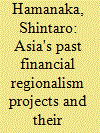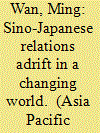|
|
|
Sort Order |
|
|
|
Items / Page
|
|
|
|
|
|
|
| Srl | Item |
| 1 |
ID:
105313


|
|
|
|
|
| Publication |
2011.
|
| Summary/Abstract |
This article analyzes five significant institutional variables related to membership and control of institutions, using comparative case studies of Asia's past regional financial projects from the 1950s through the 1990s. The five variables are: (i) countries included in or excluded from membership, (ii) membership tiers, (iii) institutional decision-making process, (iv) executive positions at organizational structure (e.g. secretariat and headquarters) of institutions, and (v) the location of the secretariat/headquarters. Past financial regionalism projects hold several important lessons for current initiatives. First, in the case of regional financial institutions, "inclusion in membership but exclusion from regional membership" is a possible option and it is crucial to go beyond the simple debate on the membership problem, namely inclusion and exclusion, when designing a regional financial institution. Second, no single country should dominate the decision-making process by voting power-an institution must maintain a delicate balance among its members in terms of voting. And finally, key to determining the success or failure of regional financial institutions is which country hosts the secretariat/headquarters and sends staff to the executive positions.
|
|
|
|
|
|
|
|
|
|
|
|
|
|
|
|
| 2 |
ID:
105310


|
|
|
|
|
| Publication |
2011.
|
| Summary/Abstract |
This article first examines specific recent issues facing the two countries, namely the Senkaku Islands fishing boat incident and the relocation of the Futenma Marine air base in Ginowan city, Okinawa, and then proceeds to make some observations on the larger issue of the future of the alliance.
|
|
|
|
|
|
|
|
|
|
|
|
|
|
|
|
| 3 |
ID:
105315


|
|
|
|
|
| Publication |
2011.
|
| Summary/Abstract |
This article traces the evolution of heightened Chinese expectations and the resultant spike in national identity in 2010, using a six-dimensional framework: 1) ideological, 2) temporal, 3) sectoral, 4) vertical, 5) horizontal, and 6) intensity. A hybrid ideology rose to the forefront. Forceful historical arguments covered three distinct periods. The triad of economic, cultural, and political identity raised sectoral identity to an unprecedented level. The leadership kept pressing the case for vertical identity in contrast to the West. Above all, it put the spotlight on horizontal identity to draw a sharper contrast with the United States and neighboring states as well. If at the time of the Hu-Obama summit the tone softened somewhat, China continued its risky wager on widening the identity gap. Regardless of whether China's foreign policy is currently assertive, its national identity narrative remains a driving force for divisiveness in the regional and international order.
|
|
|
|
|
|
|
|
|
|
|
|
|
|
|
|
| 4 |
ID:
105316


|
|
|
|
|
| Publication |
2011.
|
| Summary/Abstract |
International relations are social actions, and their expression is behavior of the states. According to French sociologist Pierre Bourdieu, the basis for any social action is habitus and capital (Bourdieu 1982). For Bourdieu, social action is not created in a vacuum but always takes place under certain social conditions. Different social conditions create different spheres that Bourdieu called action fields. The problem is that each field has its own rules, logic and goals. Bourdieu also uses the metaphor of game to explain the concept of field. Like the fields each game has also its own rules and logic. In order to participate in the game players are required to have some knowledge of game, and capacity, skills, and last but not least the interests to play game. The field of the Asia-Pacific region in the beginning of twenty-first century and especially during recent years is one of "center court" of the whole world involving all big players like the US, China, Japan, Russia and India. Their presence with their own behavior and different abilities, interests make this field more interesting, but at the same time more complicated and unpredictable. This article explores the different phases of Vietnam's foreign policy since reform in 1986 and joining ASEAN and adoption of "Resolution No. 8 (section IX) on the Strategy for Fatherland Defence in the New Context" in 1995.
|
|
|
|
|
|
|
|
|
|
|
|
|
|
|
|
| 5 |
ID:
105312


|
|
|
|
|
| Publication |
2011.
|
| Summary/Abstract |
This article explores the role of Japan in post-war Asia to endeavor to present a more accurate picture than the one-dimensional portrayal of Japan as an exclusively economic presence. By taking three viewpoints into consideration, the author attempts to provide a picture of international politics in post-war Asia as an integrated whole.
|
|
|
|
|
|
|
|
|
|
|
|
|
|
|
|
| 6 |
ID:
105311


|
|
|
|
|
| Publication |
2011.
|
| Summary/Abstract |
This article examines the "Arc of Freedom and Prosperity" which symbolizes a new direction of Japanese diplomacy and reinforced cooperation with countries where such ideals as democracy, freedom, and human rights are shared. Originally proposed by Foreign Minister Taro Aso, the concept has since moved into the background but nevertheless remains in the thoughts of current Japanese diplomatic strategy.
|
|
|
|
|
|
|
|
|
|
|
|
|
|
|
|
| 7 |
ID:
105314


|
|
|
|
|
|
|
|